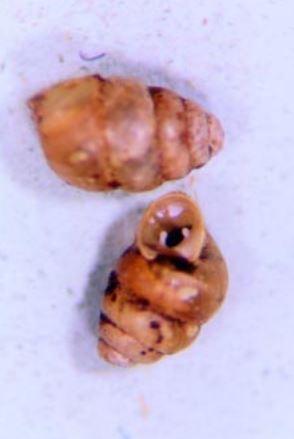Low-
Moderate
The population size of Hoko vertigo is critical in Washington and the trend is unknown. These small snails are very rare and found in small, isolated populations, perhaps remnants of a previously much wider range. These small populations are very vulnerable to logging, road building, fires, or other disturbances. The typical habitat for Vertigo snails ranges from moist riparian to relatively dry forests dominated by cottonwood, alder, Douglas-fir, spruce, or hemlock, depending on the species.
Description and Range
Physical description
The Vertiginidae family of terrestrial snails are minute (roughly .05 to 0.12 inch) with ovoid-shaped shells.
Ecology and life history
The Hoko vertigo seems to be an old-growth riparian associate. The two known locations are at the bases of wooded slopes near streams at low elevations of between roughly 40 and 300 feet; it is unknown if the species occurs at higher elevations. The habitat seems to be characterized by old trees, riparian hardwoods, and mesic conditions. This species is arboreal and has been found on trunks and lower limbs of deciduous trees, mainly alders. They are most easily detected on the undersides of limbs and leaning trunks of young alders that have relatively smooth bark.
One of the two known sites is at the base of a steep northwest-facing slope with seeps and consists of second-growth Douglas-fir forest with a sizable component of bigleaf maple. This site is near a stream; understory vegetation includes liverworts, large swordfern, and maidenhair fern. The other site is at the foot of a slope next to the Hoko River and is characterized by the presence of old hardwood trees, mostly alder.
Land snails, including Vertiginid snails, are hermaphroditic and exchange gametes with conspecific individuals when conditions are favorable. At least some species seem to retain the fertilized eggs and give birth to small numbers of live young.
The Hoko vertigo is thought to be a short-lived species with a potential life span of less than two years.
The distinctly arboreal lifestyle and mouthparts of this group of snails suggest that they feed on microorganisms growing on the surfaces of smooth-barked trees and shrubs or epiphytic lichens.
In Pacific Northwest forests, Vertiginidae snails overwinter on tree limbs, so presumably they are not killed by freezing temperatures.
Geographic range
Hoko vertigo is known only from along the east side of the Hoko River in Clallam County in the northwestern part of the Olympic Peninsula. The tendency of these snails to have a patchy distribution may make it difficult to make estimates of population size and population trends.
Surveys of roughly 300 acres in Olympic National Forest did not find any new locations. Random grid surveys across the Northwest Forest Plan area in Oregon and Washington did not locate this species in any of 498 plots searched. However, a specimen that may prove to be this species was collected in the Salem Bureau of Land Management - district of Oregon.
Climate vulnerability
Sensitivity to climate change
Low
There is limited information on the sensitivity of the Hoko vertigo snail to climate change. This species is only found at two sites on the Hoko River in the northwestern Olympic Mountains, although its range may extend into British Columbia. These two known locations are low elevation, old growth riparian areas. Because this species is so rare, it may be acutely vulnerable to fire, disease, or other events causing mass mortality as they may not be able to quickly rebuild populations.
Exposure to climate change
Moderate
- Increased disease outbreaks
- Altered fire regimes
Conservation
Conservation Threats and Actions Needed
- Agricultural side effects
- Threat: Activities that result in drying of habitat (such as logging).
- Action Needed: Protect sites.
- Resource information collection needs
- Threat: Need formal species description.
- Action Needed: Taxonomy; describe the species.
See the Climate vulnerability section for information about the threats posed by climate change to this species.
Resources
References
Duncan, N. 2005. Conservation Assessment for Vertigo n. sp., Hoko Vertigo. Originally issued as Management Recommendations by John S. Applegarth, February 1999. Revised by Nancy Duncan, October 2005. USDA Forest Service Region 6 and USDI Bureau of Land Management, Oregon and Washington, 16 pp.
Burke, T. E. 2013. Land Snails and Slugs of the Pacific Northwest. Oregon State University Press, Corvallis, OR. 344 pp.
Frest, T. J. 1999. A Review of the land and freshwater Mollusks of Idaho. Final report to the Idaho Conservation Data Center, Idaho Department of Fish and Game, 600 South Walnut, P.O. Box 25, Boise, Idaho 83707. 281 pp. plus appendices.
Jordan, S. 2013. Vertigo andrusiana (Pilsbry 1899) Pacific Vertigo. Species Fact Sheet. Xerces Society. Prepared for the Interagency Special Status/Sensitive Species Program, Forest Service, Bureau of Land Management.
NatureServe. 2014. NatureServe Explorer: An online encyclopedia of life [web application]. Version 7.1. NatureServe, Arlington, Virginia. Available http://explorer.natureserve.org. (Accessed September 11, 2014 ).
Pilsbry, H. A. 1948. Land Mollusca of North America (north of Mexico). Monograph of the Academy of Natural Sciences of Philadelphia, 2(2): 521-1113.
USFWS. 2011. Endangered and Threatened Wildlife and Plants: 90-day finding on a petition to list 29 mollusk species as threatened or endangered with critical habitat: proposed rule. Federal Register 76 (No. 193, October 5, 2011): 61826-61853.
